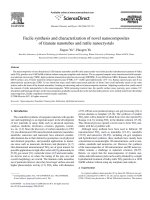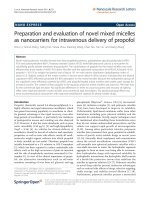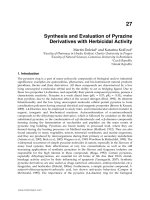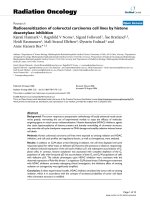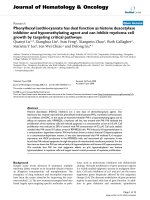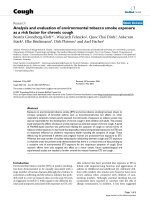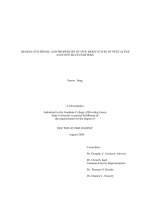DESIGN, SYNTHESIS, AND EVALUATION OF NOVEL N-HYDROXYBENZAMIDES/N-HYDROXYPROPENAMIDES INCORPORATING QUINAZOLIN-4(3H)-ONES AS HISTONE DEACETYLASE INHIBITORS AND ANTITUMOR AGENTS (Báo cáo tóm tắt HN KHCN TT 2018)
Bạn đang xem bản rút gọn của tài liệu. Xem và tải ngay bản đầy đủ của tài liệu tại đây (280.7 KB, 2 trang )
DESIGN, SYNTHESIS, AND EVALUATION OF NOVEL
N-HYDROXYBENZAMIDES/N-HYDROXYPROPENAMIDES
INCORPORATING QUINAZOLIN-4(3H)-ONES AS HISTONE
DEACETYLASE INHIBITORS AND ANTITUMOR AGENTS
Duong Tien Anh (Hanoi University of Pharmacy), Doan Thanh Hieu (Thai Nguyen
University of Medicine and Pharmacy), Tran Diem Huong (Hanoi University of Pharmacy),
Nguyen Tran Phuong Linh (Hanoi University of Pharmacy)
Instructors:
Nguyen Hai Nam, Ph.D., Professor (Department of Pharmaceutical Chemistry,
Hanoi University of Pharmacy)
Phan Thi Phuong Dung, Ph.D., Associate Professor (Department of Pharmaceutical
Chemistry, Hanoi University of Pharmacy)
Background
Molecular target-based approach has become a mainstream in new drug design and
development nowadays, including the field of anticancer drugs. Among many protein targets
currently used for the design of novel anticancer agents, histone deacetylases (HDAC)
emerge as very attractive one. To date, at least five HDAC inhibitors have been approved
for use to treat several types of cancer. These include suberoylanilide hydroxamic acid
(SAHA), romidepsin, belinostat, panobinostat, and chidamide. Addition, quinazolin-4(3H)one moiety is a common scaffold found in many diverse biological compounds. The
quinazoline system, inparticular, has been present as a core structure in a number of tyrosine
kinase inhibitors and anticancer agents (e.g. gelfitinib, erlotinib). Inspired by these results,
we expanded our design to the new series of N-hydroxybenzamides and Nhydroxypropenamides incorporating a quinazolin-4(3H)-one moiety as a capping group.
The primary concern of this research is design, synthesis of N-hydroxybenzamides and
N-hydroxypropenamides series incorporating quinazolin-4(3H)-ones. Then the synthesized
compounds were evaluated their HDAC inhibitory ability and cytotoxicity against three
human cancer cell lines, including SW620, PC3, and NCI-H23.
Materials and methods
Chemistry
All reagents and solvents were purchased from Sigma-Aldrich (USA) or Merck.
Solvents were used directly as purchased unless otherwise indicated. TLC which was
performed using Whatman® 250 mm Silica Gel GF Uniplates. Melting points were
measured using a Gallenkamp Melting Point Apparatus (UK) and are uncorrected. Nuclear
magnetic resonance spectra were recorded on a Bruker 500 MHz spectrometer with DMSOd6 as solvent unless otherwise indicated. Tetramethylsilane was used as an internal standard.
Chemical shifts are reported in parts per million (ppm), downfield from tetramethylsilane.
Mass spectra were recorded on LC-MSD-Trap-SL mass spectrometer for ESI.
The synthesis of N-hydroxybenzamides/propenamides series incorporating
quinazolin-4(3H)-ones (4, 8, 10) was carried out as illustrated in Schemes 1-3.
Scheme 1. Synthesis of N-hydroxybenzamides incorporating quinazolin-4(3H)-one (4a-h)
Scheme 2. Synthesis of N-hydroxybenzamides incorporating 2-methylquinazolin-4(3H)-one (8a-d)
Scheme 3. Synthesis of N-hydroxypropenamides incorporating quinazolin-4(3H)-one (10a-d)
Bioactivity
The HDAC enzymes (Hela cell nuclear extract) were purchased from Enzo Life
Sciences Inc. (Farmingdale, New York, USA). The HDAC enzymatic assay was performed
using a Fluorogenic HDAC Assay Kit (Enzo Life Sciences Inc.) according to the
manufacturer’s instructions.
The cytotoxicity of the synthesized compounds was evaluated against three human
cancer cell lines, including SW620 (colon cancer), PC3 (prostate cancer), and NCI-H23
(lung cancer). The IC50 values were calculated using a Probits method.
Results
Chemistry:
+ The targeted hydroxamic acids (4, 8, 10) were synthesized via three or four step
pathway, as illustrated in Schemes 1-3.
+ The purity of targeted compounds were determined based on TLC and the value of
melting point range.
+ The structures of the synthesized compounds were determined straightforwardly
based on analysis of spectroscopic data, including IR, MS, 1H and 13C NMR.
Bioactivity:
In general, the synthesized compounds exhibited good HDAC inhibitory effects with
IC50 values in a sub-micromolar range in most cases. The synthesized compounds have
potent cytotoxicity against three human cancer cell lines, including SW620 (human colon
cancer), PC-3 (prostate cancer), and NCI-H23 (lung cancer).
Conclusion
In conclusion, we have reported two series of N-hydroxybenzamides and Nhydroxypropenamides incorporating quinazolin-4(3H)-one moiety with strong HDAC
inhibitory effects and potent cytotoxicity against three human cancer cell lines, including
SW620 (human colon cancer), PC-3 (prostate cancer), and NCI-H23 (lung cancer). The
results we obtained from this study again confirm that quinazolin-4(3H)-one could well
serve as a capping group for HDAC inhibitors.
Keywords: Histone deacetylase (HDAC), hydroxamic acids, quinazolin-4(3H)-one.
